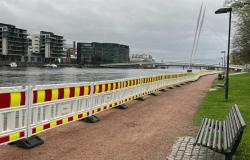The report “Sea level rise and extremes in Norway” describes how the sea is expected to rise along the Norwegian coast towards the middle and end of this century, and further towards the year 2300. The report has been prepared by the Norwegian Climate Services Center (Mapping Authority, Meteorological Institute, NORCE) and the Nansen Center at commission from the Norwegian Environment Agency.
– The report shows yet another serious challenge from climate change. Seas will rise as global temperatures increase. When combined with storm surges and wave action, it can have significant consequences along our long coast. More areas may remain under water – periodically or permanently – in the future. We have to take that into account when planning land use and try to prevent serious consequences, says Ellen Hambro, director of the Norwegian Environment Agency.
You can read the report here: “Sea level rise and extremes in Norway”
– The sea will rise more than the land rises
Global warming causes the sea to rise, both because the water expands when it gets warmer, and because ice on land melts and flows into the sea. Sea level rise will vary between different parts of the coast in Norway, because the land uplift after the last ice age is different.
– In Norway, we have so far experienced little of the consequences of sea level rise, since land uplift makes up for rising sea levels. However, this report shows that the situation is about to change. In some places, we already see that the sea is rising more than the land is rising, says the environment director.
Increased risk of flooding from the sea
The sea level rises fastest along the coast in Southern and Western Norway and outside Northern Norway, because the land in these areas rises more slowly than around the Oslofjord and in central Norway.
A few decimetres of sea level rise may sound undramatic, but such a change increases the risk of flooding from the sea. Exposed areas are flooded more often, and the water will now reach further inland. In the long term, parts of Norway will remain under water as a result of sea level rise.
Sea level rise cannot be reversed – emission cuts determine the extent
Climate change will determine how much the sea level along the Norwegian coast will rise towards 2100 and beyond. The higher the temperature on Earth, the more the sea will rise. If the global average temperature increases by more than 2 degrees, the risk of significant sea level rise in Norway increases.
– Due to the long response time of the sea and the inland ice to a warmer climate, the sea level rise we are already seeing today will continue for hundreds to thousands of years to come. There is considerable uncertainty about the outcome. How much the sea level will rise depends largely on how well the world succeeds in cutting greenhouse gas emissions. At the same time as we prepare for what is to come, all countries must therefore work hard to avoid the most dramatic consequences that will affect the generations that come after us, says Hambro.
The report has calculated how much the sea will rise in Norway based on various scenarios for global warming, and is based on updated data from the UN Climate Panel’s sixth main report.
Also read: UN Climate Panel on the Ocean
The risk is limited if we reach the Paris Agreement
Global warming below 2 degrees:
- If global warming is limited to below 2 degrees by the year 2100, the sea in Norway will rise by an average of 0.13 meters compared to the period 1995-2014. Depending on where you are in the country, the number will be higher or lower.
- Large parts of southern and western Norway and some parts of northern Norway will probably experience sea level rise, while the sea level along the rest of the coast will be able to remain stable if average global warming is limited to 2 degrees.
Global warming above 2 degrees:
- If the level of greenhouse gas emissions continues as it is today and the average temperature on earth exceeds 2 degrees, it is expected that the sea will rise along most of Norway’s coast during this century.
- With today’s adopted policy for emission reductions on a worldwide basis, we are moving towards a global warming of close to 3 degrees, which is expected to give a few decimetres (less than one metre) of sea level rise until the year 2100. For example, Oslo will experience something between -10 and 40 cm, Stavanger 20 to 70 cm, and Tromsø 0 to 50 cm.
- If global warming exceeds 2 degrees, rapid ice loss from Antarctica cannot be ruled out. In that case, it could lead to Norway experiencing a significantly higher sea level rise.
Global warming around 4 degrees:
- The report has also looked at scenarios with a low probability, but which could have major consequences if they first occur.
- Strong global warming with a temperature increase of around 4 degrees globally, combined with rapid ice loss in Antarctica, will mean that areas along the Norwegian coast, especially Stavanger and Bergen, may experience a sea level rise of close to 2 meters by the year 2100.
- Shortly after the year 2100, massive ice loss from Antarctica can cause the average sea level in Norway to rise rapidly to between 4.5 and 5 meters by the year 2150.
Factbox about the report “Sea level rise and extremes in Norway”
- The report has been prepared by the Norwegian Climate Services Center at the Mapping Authority (project manager), the Meteorological Institute and NORCE, in collaboration with the Nansen Centre, on behalf of the Norwegian Environment Agency.
- The report describes how the sea is expected to rise along the Norwegian coast towards the middle and end of this century, and further towards the year 2300, in various scenarios for global warming.
- The figures for sea level rise are based on updated data from the UN Climate Panel’s sixth main report, tailored to Norwegian areas.
- The Directorate for Social Security and Preparedness (DSB) prepares an accompanying guide for the municipalities on how the results from the report can be used in municipal planning.
- The results from the report will form part of the knowledge base for the upcoming report “Climate in Norway 2100” from the Norwegian Climate Services Center
- The Norwegian Climate Services Center organizes and disseminates climate and hydrological data so that they can be used for climate adaptation and in further research into the effects of climate change on nature and society.






